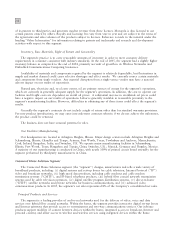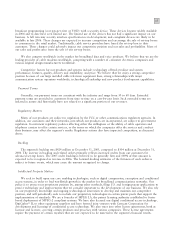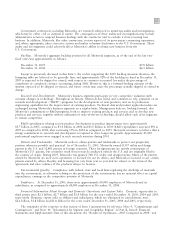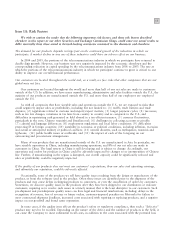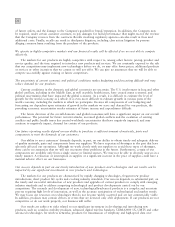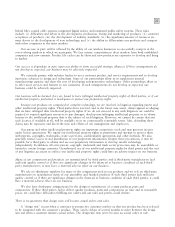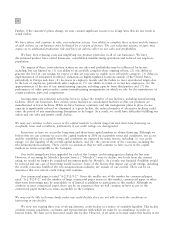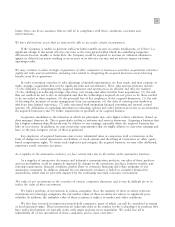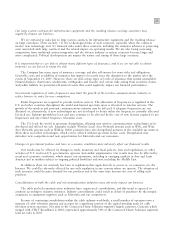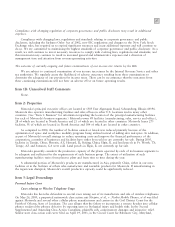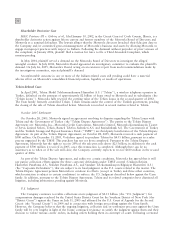Motorola 2005 Annual Report Download - page 27
Download and view the complete annual report
Please find page 27 of the 2005 Motorola annual report below. You can navigate through the pages in the report by either clicking on the pages listed below, or by using the keyword search tool below to find specific information within the annual report.
20
of future orders, and the damage to the Company's goodwill or brand/reputation. In addition, the Company may
be required, under certain customer contracts, to pay damages for failed performance that might exceed the revenue
that the Company receives from the contracts. Recalls involving regulatory agencies can also result in fines and
additional costs. Finally, recalls can result in third-party litigation, including class action litigation by persons
alleging common harm resulting from the purchase of the products.
We operate in highly-competitive markets and our financial results will be affected if we are not able to compete
effectively.
The markets for our products are highly competitive with respect to, among other factors: pricing, product and
service quality, and the time required to introduce new products and services. We are constantly exposed to the risk
that our competitors may implement new technologies before we do, or may offer lower prices, additional products
or services or other incentives that we cannot or will not offer. We can give no assurances that we will be able to
compete successfully against existing or future competitors.
The uncertainty of current economic and political conditions makes budgeting and forecasting difficult and may
reduce demand for our products.
Current conditions in the domestic and global economies are uncertain. The U.S. involvement in Iraq and other
global conflicts, including in the Middle East, as well as public health issues, have created many economic and
political uncertainties that have impacted the global economy. As a result, it is difficult to estimate the level of
growth for the world economy as a whole. It is even more difficult to estimate growth in various parts of the
world economy, including the markets in which we participate. Because all components of our budgeting and
forecasting are dependent upon estimates of growth in the markets we serve and demand for our products, the
prevailing economic uncertainties render estimates of future income and expenditures difficult.
The future direction of the overall domestic and global economies will have a significant impact on our overall
performance. The potential for future terrorist attacks, increased global conflicts and the escalation of existing
conflicts and public health issues has created worldwide uncertainties that have negatively impacted, and may
continue to negatively impact, demand for certain of our products.
Our future operating results depend on our ability to purchase a sufficient amount of materials, parts and
components to meet the demands of our customers.
Our ability to meet customers' demands depends, in part, on our ability to obtain timely and adequate delivery
of quality materials, parts and components from our suppliers. We have experienced shortages in the past that have
adversely affected our operations. Although we work closely with our suppliers to avoid these types of shortages,
there can be no assurances that we will not encounter these problems in the future. Furthermore, certain of our
components are available only from a single source or limited sources. We may not be able to diversify sources in a
timely manner. A reduction or interruption in supplies or a significant increase in the price of supplies could have a
material adverse effect on our businesses.
Our success depends in part on our timely introduction of new products and technologies and our results can be
impacted by our significant investments in new products and technologies.
The markets for our products are characterized by rapidly changing technologies, frequent new product
introductions, short product life cycles and evolving industry standards. Our success depends, in substantial part, on
the timely and successful introduction of new products and upgrades of current products to comply with emerging
industry standards and to address competing technological and product developments carried out by our
competitors. The research and development of new, technologically-advanced products is a complex and uncertain
process requiring high levels of innovation, as well as the accurate anticipation of technological and market trends.
We may focus our resources on technologies that do not become widely accepted and are not commercially viable.
In addition, products may contain defects or errors that are detected only after deployment. If our products are not
competitive or do not work properly, our business will suffer.
Our results are subject to risks related to our significant investment in developing and introducing new
products, such as: seamless mobility products, advanced digital wireless handsets; CDMA2000 1X, UMTS and other
advanced technologies for wireless networks; products for transmission of telephony and high-speed data over




